clothing worn in ancient Egypt from the end of the Neolithic period (prior to 3100 BC) to the collapse of the Ptolemaic dynasty with the death of Cleopatra VII in 30 BC. Egyptian clothing was filled with a variety of colors. Adorned with precious gems and jewels, the fashions of the Ancient Egyptians were made for not only beauty but also comfort. Egyptian fashion was created to keep cool while in the hot desert.
Elements of Egyptian clothing
In ancient Egypt, linen was by far the most common textile. It helped people to be comfortable in the subtropical heat. Linen is made from the flax plant by spinning the fibers from the stem of the plant. Spinning, weaving and sewing were very important techniques for all Egyptian societies. Plant dyes could be applied to clothing but the clothing was usually left in its natural color. Wool was known, but considered impure. Only the wealthy wore animal fibers that were the object of taboos. They were used on occasion for overcoats, but were forbidden in temples and sanctuaries.
Peasants, workers and other people of modest condition often wore nothing, but the shenti (made of flax) was worn by all people. Slaves often worked naked.
The most common headdress was the khat or nemes, a striped cloth worn by men.
Peasants, workers and other people of modest condition often wore nothing, but the shenti (made of flax) was worn by all people. Slaves often worked naked.
The most common headdress was the khat or nemes, a striped cloth worn by men.
Pharaohs
Royal clothing is particularly well documented, as well as the clothing and crowns of the Pharaohs.The pharaohs would wear leopard skins over their shoulders and added a lion’s tail that would hang from their belt.
Men
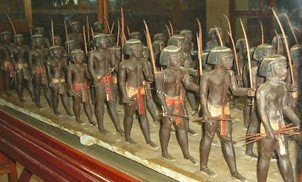 From about 2130 BC during the Old Kingdom, garments were simple. The men wore wrap around skirts known as the Shendyt, which were belted at the waist, sometimes pleated or gathered in the front. During this time, men's skirts were short. As the Middle Kingdom of Egypt, 1600 B.C., came, the skirt was worn longer. Then, around 1420 BC, there was a light tunic or blouse with sleeves, as well as a pleated petticoat.
From about 2130 BC during the Old Kingdom, garments were simple. The men wore wrap around skirts known as the Shendyt, which were belted at the waist, sometimes pleated or gathered in the front. During this time, men's skirts were short. As the Middle Kingdom of Egypt, 1600 B.C., came, the skirt was worn longer. Then, around 1420 BC, there was a light tunic or blouse with sleeves, as well as a pleated petticoat.Women
During the Old, Middle and New Kingdom, Ancient Egyptian women often wore simple sheath dresses called kalasiris. Women's clothing in ancient Egypt was more conservative than men's clothing.The dresses were held up by one or two straps and were worn down to the ankle, while the upper edge could be worn above or below the breasts. The length of the dress denoted the social class of the wearer. Beading or feathers were also used as an embellishment on the dress. Over the dress, women had a choice of wearing shawls, capes, or robes. The shawl was a piece of cloth around 4 feet wide by 13 or 14 feet long. This was mostly worn pleated as well. Female clothes only changed slightly through the millennia. Draped clothing (with many varieties of drapery) sometimes gave the impression of completely different clothing. It was made of haïk, a very fine muslin.
Children
Children wore no clothing until 6 years old. Once they turned six years old they were allowed to wear clothing to protect them from the dry heat.A popular hairstyle among the children was the side-lock on the right side of the head. Even though children usually wore no clothing, they wore jewelry such as anklets, bracelets, collars, and hair accessories. When they grew up, they wore the same styles as their parents.
Wigs
Wigs, common to both genders, were worn by wealthy people of society. Made from real human and horse hair, they had ornaments incorporated into them. They were often woven into certain hairstyles and were quite inexpensive. In the royal court, women sometimes wore cuplets filled with perfume. They were worn to also keep out head lice and protected the head when doing dangerous things.
Jewelry
Jewelry was very popular in Ancient Egypt, no matter the social class. It was heavy and rather voluminous. The Egyptians became very skilled when making jewelry from turquoise, metals like gold and silver, and small beads. Both men and women adorned themselves with earrings, bracelets, rings, necklaces and neck collars that were brightly colored. Those who could not afford jewelry made from gold or other stones would make their jewelry from colored pottery beads.
One creation that was specific to ancient Egypt was the gorgerine, an assembly of metal discs worn on the chest, either over bare skin or over a shirt, and attached in the back.
Cosmetics
Embalming allowed the development of cosmetics and perfumes. The perfumes of Egypt were the most numerous, but also the most sought and the costliest of antiquity, which used them extensively. The Egyptians used makeup most of all the ancient people. Nails and hands were painted with henna.
Black kohl, which was used to mark eyes, was obtained from galena. Eye shadow was made from crushed malachite. Red, which was applied to lips, came from ochre. These products were mixed with animal fat to make them compact and to preserve them. They wore galena or crushed malachite not just to enhance beauty, but because they believed it kept dust and dirt from getting into their eyes. For this reason, both men and women wore it.
Findings were published by American Chemical Society in the journal Analytic Chemistry suggest that the use of lead in makeup was intentional. Findings suggest that the lead in combination with salts produced naturally by the body produce nitric oxide which boosts the immune system. It is believed that the production and result were intentional. The increase in immune productivity would help to prevent infections like conjunctivitis.
Footwear
Footwear was the same for both genders. It consisted of sandals of leatherwork, or for the priestly class, papyrus. Since Egyptians were usually barefoot, sandals were worn on special occasions or at times when their feet might get hurt


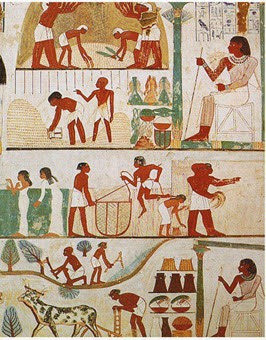
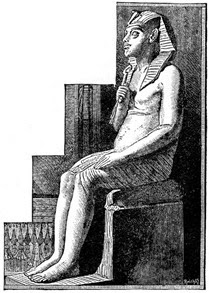

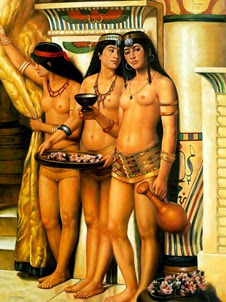
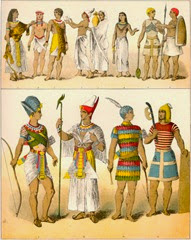
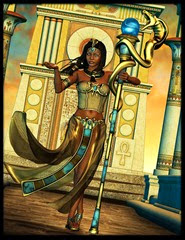
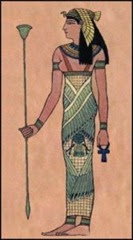
EmoticonEmoticon